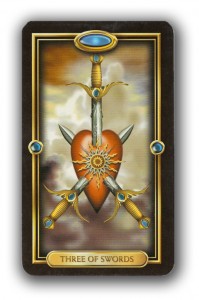Straw into Gold Technique
If you haven’t already read the previous blog post, take a minute and check that out for some background information.
Also I should reiterate that I use the phrase “bad card” somewhat tongue-in-cheek. Most tarot readers agree that there are no “bad” cards, that all the cards have gifts and shadows. When I use the phrase “bad” card I mean a card that you (or your client) is having trouble seeing the gift or a card that indicates an undesired outcome. The exercises given by Elinor are ways we can find the gift in any card.
After we completed the Burden into Blessings spread, Elinor taught her Gestalt Therapy “Be the Card” Technique. She tells us that:
“This is a projective technique that is derived from the way that Gestalt Therapists work with dreams. Gestalt Therapy believes that one cannot help projecting one’s own issues into everything that we experience. The act of projecting oneself inot a picture and speaking in the first person as the different parts of the picture often brings a sudden, useful increase in self-awareness and new insight into one’s situation.”
The first step is to look at the “bad card” and pretend to be the card (we’ll use the 3 of Swords as an example), describing it in detail in the first person: “I am the 3 of Swords and in me are a red heart pierced by 3 swords and some clouds and rain.” Make a note of each item listed and labeled them a, b, c, and d, etc.

- Heart
- Swords
- Clouds
- Rain
Second, describe what is happening in the card in the first person from the prospective of each item listed. For example, “I am a red heart pierced by swords. I hurt and want someone to pull the swords out of me. I can feel myself pulsing and beating, but the places where the swords are piercing me can’t move at all.”
Third, have item a talk to item b, etc. For example:
The heart to the swords: “why are you piercing me?”
The swords to the heart: “there is nowhere else for us to go. Why won’t you accept us?”
For me, I found it quite enough to stop here. The revelations were clear and obvious. However, Elinor suggests wrapping up with the following questions:
- What is it like being this card?
- Is there any situation in your life that feels similar to what you have said about this card? How is it similar?
- If the answer to the above is “no” ask: “how is your life different from what you have said about this card?”
- If this were an animated cartoon, what would happen next in this card?
I can see using this in my practice when if a client gets really hung up on a card and is willing to be interactive. Give it a try and let me know what you think.










This informatin is perfect timing. I got this card in the advice position in a reading yesterday. These steps really add a lot of depth and tons more understanding to the reading in general and to the 3 of swords card specifically. Thank you!
Ooh, this sounds amazing! There’s something similar in Mary K. Greer’s 21 Ways to read a tarot card, but the slant of doing it specifically for difficult cards is excellent. I will definitely try this. Thanks for blogging it, Barbara.
This is an awesome technique! I might try this in my Tarot class this weekend–I’ve been looking for ways to address “bad” cards and to help the students see them from a different perspective.
Thanks so much, Barbara!